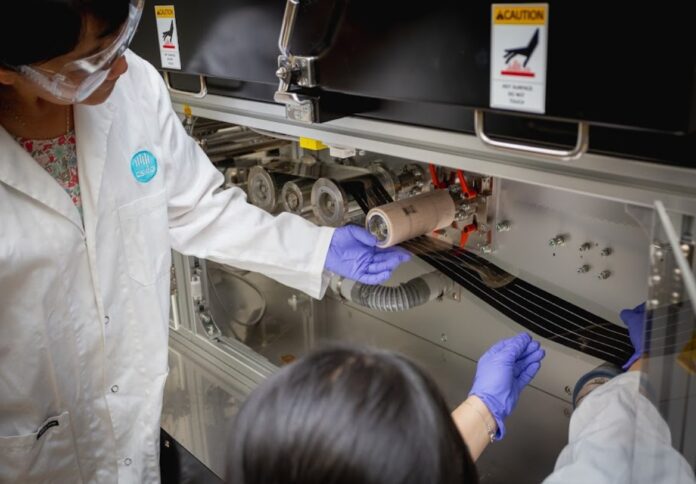
Scientists at Australia’s national science agency CSIRO have achieved a groundbreaking feat in solar technology, setting a new efficiency record for fully roll-to-roll printed solar cells.
This breakthrough marks a crucial moment in the pursuit of renewable energy, as the printed solar cells, crafted on thin plastic films, offer a lightweight and flexible alternative to traditional silicon panels.
In particular, the innovative production method employed by CSIRO involves fully printing all components of the device from inks, utilizing roll-to-roll techniques on long, continuous rolls of plastic.
The research team has demonstrated remarkable performances for these solar cells, achieving an efficiency of 15.5 per cent on a small scale and 11 per cent for a 50 cm2 module.
These figures represent a new record for fully printed solar cells, showcasing the potential of this technology on a larger scale.
At the heart of these advancements lies perovskite, an emerging class of solar material that can be formulated into inks for printing.
This, combined with automated screening to optimise the printing process, has paved the way for these achievements, CSIRO reported.
Dr Anthony Chesman, CSIRO’s Renewable Energy Systems Group leader, hailed the achievement as the culmination of over a decade of dedicated research and development.
The flexibility and portability of these innovative solar cells herald a new era in energy production, opening avenues for deployment in diverse sectors including urban construction, mining, emergency response, space exploration, and personal electronics.
Unlike conventional silicon panels, the lightweight nature of printed solar cells facilitates easy transportation and installation in previously inaccessible areas.
“Roll-to-roll printing allows for the solar cells to be manufactured on very long, continuous rolls of plastic, which can dramatically increase the rate of production,” Dr Chesman stressed.
Leveraging methods already entrenched in the printing industry, CSIRO said the adoption of these technologies could significantly bolster Australia’s manufacturing sector while driving down production costs.
“The successful commercialisation of printed flexible solar cells has the potential to create significant economic and environmental benefits for Australia and the world,” he said.
The research, conducted in collaboration with esteemed institutions such as the University of Cambridge, Monash University, the University of Sydney, and the University of New South Wales, has been published in the journal Nature Communications.
Lead author Dr Doojin Vak underscored the role of automation in achieving this milestone, noting the invaluable insights gleaned from rapid production and testing of thousands of solar cells daily.
Dr Vak elucidated how perovskite’s compatibility with industrial printing processes has paved the way for a more sustainable and accessible approach to solar energy production.
By circumventing the need for expensive metals like gold and employing specialised carbon inks, CSIRO said it aims to further drive down production costs, making solar energy more economically viable.
While acknowledging that perovskite solar cells currently lag behind silicon counterparts in efficiency and longevity, Dr Chesman emphasised the unique advantages of flexible panels.
“As these perovskite solar cells are printed onto plastic films, they are very lightweight, highly flexible and portable,” he said.
“The rigidity and weight of conventional silicon solar panels can make moving them difficult. Our thin, lightweight solar can be easily transported anywhere there is sun.”
CSIRO said it is actively pursuing collaborations with industry partners to advance and bring this technology to commercialisation.
Funding for this project was provided by ARENA as part of their Research and Development Program focused on Solar PV Research.
















